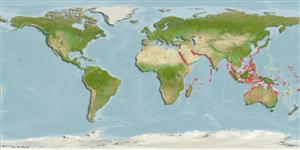Teleostei (teleosts) >
Gobiiformes (Gobies) >
Gobiidae (Gobies) > Gobiinae
Etymology: Pleurosicya: Greek, pleura = side, ribe + Greek, sikya, -as = cucumber (Ref. 45335).
Environment: milieu / climate zone / depth range / distribution range
Ecology
Marine; demersal; depth range 3 - 15 m (Ref. 90102). Tropical
Indo-West Pacific: Red Sea, Egypt and Israel, Thailand and Australia.
Size / Weight / Age
Maturity: Lm ? range ? - ? cm
Max length : 1.7 cm TL male/unsexed; (Ref. 83991)
Dorsal spines (total): 6 - 7; Dorsal soft rays (total): 8 - 9; Anal spines: 1; Anal soft rays: 8 - 9. Characterized by semi-transparent; iris red; head and body with numerous pepper-like melanopores, concentrated on side below dorsal fins; longitudinal scale series 15-27; mostly scaleless head and anterior third of body; restricted gill opening to pectoral fin base; extremely elongated tip of upper jaw and lip, looks like curved beak; depth of body at anus 4.2-7.1 in SL (Ref. 90102).
Body shape (shape guide): elongated; Cross section: compressed.
Commensal with large staghorn corals in 3-15 m (Ref 90102).
Life cycle and mating behavior
Maturity | Reproduction | Spawning | Eggs | Fecundity | Larvae
Goren, M. and M. Dor, 1994. An updated checklist of the fishes of the Red Sea (CLOFRES II). The Israel Academy of Sciences and Humanities, Jerusalem, Israel. 120 p. (Ref. 12541)
IUCN Red List Status (Ref. 130435: Version 2025-1)
Threat to humans
Harmless
Human uses
Tools
Special reports
Download XML
Internet sources
Estimates based on models
Preferred temperature (Ref.
123201): 25 - 29.3, mean 28.5 °C (based on 2442 cells).
Phylogenetic diversity index (Ref.
82804): PD
50 = 0.5000 [Uniqueness, from 0.5 = low to 2.0 = high].
Bayesian length-weight: a=0.00724 (0.00339 - 0.01546), b=3.10 (2.92 - 3.28), in cm total length, based on LWR estimates for this (Sub)family-body shape (Ref.
93245).
Trophic level (Ref.
69278): 3.0 ±0.3 se; based on size and trophs of closest relatives
Resilience (Ref.
120179): High, minimum population doubling time less than 15 months (Preliminary K or Fecundity.).
Fishing Vulnerability (Ref.
59153): Low vulnerability (10 of 100).
🛈
